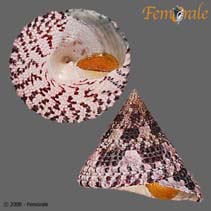Trochus maculatus Linnaeus, 1758
Maculated topWarning: DOMDocument::load(): SSL operation failed with code 1. OpenSSL Error messages: error:140770FC:SSL routines:SSL23_GET_SERVER_HELLO:unknown protocol in C:\Apache24\htdocs\includes\SpeciesSummary.lib.php on line 1236
Warning: DOMDocument::load(): Failed to enable crypto in C:\Apache24\htdocs\includes\SpeciesSummary.lib.php on line 1236
Warning: DOMDocument::load(https://sealifebase.nrm.se/webservice/AquaMaps/getAMap.php?genus=Trochus&species=maculatus): failed to open stream: operation failed in C:\Apache24\htdocs\includes\SpeciesSummary.lib.php on line 1236
Warning: DOMDocument::load(): I/O warning : failed to load external entity "https://sealifebase.nrm.se/webservice/AquaMaps/getAMap.php?genus=Trochus&species=maculatus" in C:\Apache24\htdocs\includes\SpeciesSummary.lib.php on line 1236
Classification / Names Common names | Synonyms | CoL | ITIS | WoRMS
| Trochida | Trochidae
Environment: milieu / climate zone / depth range / distribution range Écologie
; profondeur 0 - 10 m (Ref. 349). Tropical
Distribution Pays | Zones FAO | Écosystèmes | Occurrences | Introductions
Indo-West Pacific: from East Africa to Melanesia; north to Japan, and south to southern Queensland and New Caledonia.
Length at first maturity / Taille / Poids / Âge
Maturity: Lm ? range ? - ? cm Max length : 7.0 cm SHH mâle / non sexé; (Ref. 821); common length : 5.0 cm SHL mâle / non sexé; (Ref. 349)
Description synthétique Morphologie
Shell conical, solid with flat base. Concave, flat or convex whorls with sudes covered with several spiral rows of irregualrly sized granules. Colouration: shell with axial streaks; base with radiating streaks or spots (Ref. 128042).
Common in rocky shores, from low in the intertidal zone (Refs. 349, 128042). Subtidal, on rocks approaching reefs (Refs. 799, 128042) (Ref. 349).
Life cycle and mating behavior Maturité | Reproduction | Frai | Œufs | Fécondité | Larves
Members of the order Archaeogastropoda are mostly gonochoric and broadcast spawners. Life cycle: Embryos develop into planktonic trocophore larvae and later into juvenile veligers before becoming fully grown adults.
Référence principale
Références | Coordinateur | Collaborateurs
Poutiers, J.M. 1998. (Ref. 349)
Statut dans la liste rouge de l'IUCN (Ref. 130435)
statut CITES (Ref. 108899)
Not Evaluated
CMS (Ref. 116361)
Not Evaluated
Menace pour l'homme
Harmless
Utilisations par l'homme
| FishSource |
Outils
Plus d'informations
Pays
Zones FAO
Écosystèmes
Occurrences
Introductions
Stocks
Écologie
Régime alimentaire
Éléments du régime alimentaire
Zones FAO
Écosystèmes
Occurrences
Introductions
Stocks
Écologie
Régime alimentaire
Éléments du régime alimentaire
Sources Internet
BHL | BOLD Systems | CISTI | DiscoverLife | FAO(Publication : search) | Fishipedia | GenBank (genome, nucleotide) | GloBI | Gomexsi | Google Books | Google Scholar | Google | PubMed | Arbre de Vie | Wikipedia (Go, chercher) | Zoological Record
Estimates based on models
Preferred temperature
(Ref. 115969): 24.7 - 29.3, mean 28.5 (based on 3112 cells).
Catégorie de prix
(Ref. 80766):
Unknown.



